Glancam
Houses within 15km of this house
Displaying 89 houses.
Houses within 15km of Glancam
Displaying 89 houses.
| House name | Description | |
|---|---|---|
| Old Dromore | Smith refers to the "pleasant seat" of Sir Matthew Deane, "lately rebuilt, with an elegant front of hewn stone". A larger house built in the early 1780s was dismantled almost as soon as it was built by Sir Robert Deane, lst Baron Muskerry. Hajba writes that Jeremiah and Richard Gifford Campion occupied Dromore Old in the last decade of the 18th century. A house valued at £23 in the mid 19th century was the home of the Williamson family located on the Purcell estate. Occupied by U[sher] Williamson in 1814, Reverend Benjamin Williamson in 1837 and in the early 1850s. In 1894 Slater refers to it as the residence of Mrs. Williamson. In the latter half of the 20th century the home of the Hegartys. A house is still extant at Dromore. | |
| Aldworth | Hajba writes that this house was occupied by members of the Bolster family who held it from the Newmans in the late 18th century. It then became a Lombard property and passed from them to a relative, James Hunt. In the early 1850s it was occupied by James Laurence Cotter, held from James Hunt and valued at £14. This house is still occupied. Another house close by named Aldworth Lodge was also a Bolster home valued at £4+ at the time of Griffith's Valuation. A house is also extant at the latter site. |

|
| Danesfort | According to Hajba built by James Butler Stopford in the very early 19th century, replacing an earlier cottage. Stopford sold his interest to his brother-in-law, Captain Edmund Lombard a few years later. At the time of Griffith's Valuation it was occupied by the Captain's nephew, James Hunt, who held the property valued at £27.15 shillings from Christopher Crofts. In 1944 the Irish Tourist Association survey noted that it was the residence of Stopford Hunt. The house was destroyed by fire in the 1950s. | |
| Fern Hill | Smith records Cornelius Townshend as resident at Betsborough circa 1750. Hajba writes that it was a Townsend property from the early 18th century and birthplace of the United Irishman, Thomas Russell, executed in 1803. The house, on the outskirts of the village of Drommahane, was originally known as Bettesborough (or Besborough) and a Magner occupied a house of this name in 1837. The Reverend Philip Townsend held the house valued at £21+ from William Magner in the early 1850s. In June 1881 the house and demesne of Fernhill were advertised for sale. Barclay Corrie was the owner, holding on a lease dated 1863 from Richard John Perry to Michael Joseph Magnier. The house was demolished in the early 20th century and a new house built on the site. |
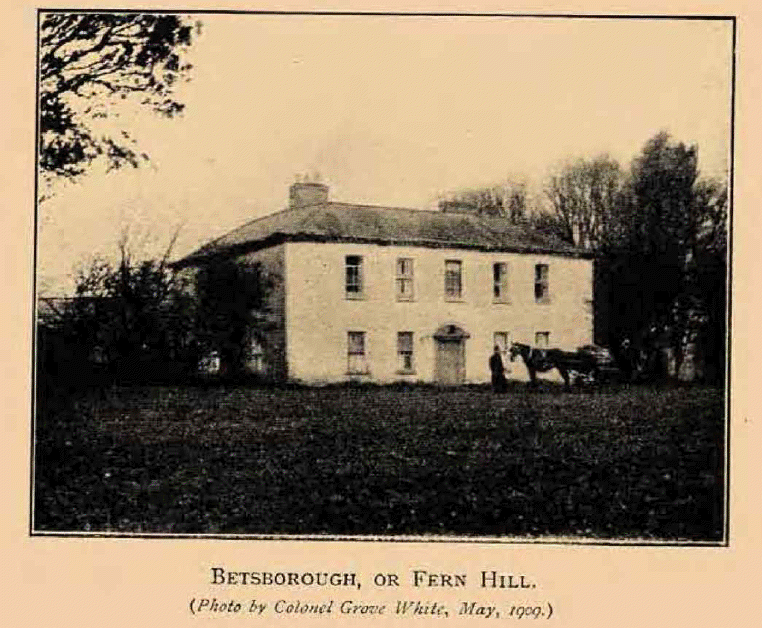
|
| Newberry Manor | This house was the seat of the Newman family in the 18th and 19th centuries. In 1786 Wilson refers to it as "Dromore, the seat of Mr. Newman". The house was valued at almost £49 in the mid 19th century and held by Adam Newman in fee. John R.B. Newman was resident in 1906. The house was burnt in June 1921 during the War of Independence when it was owned by John R. Pretyman Newman. It was rebuilt by the Newmans and then sold to the Poor Sisters of Nazareth as a nursing home. |
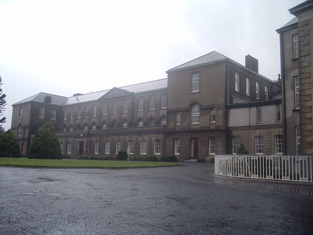
|
| Derry | The home of the Gibbs family in the 18th and early 19th centuries. It was occupied by J.B. Gibbs in 1837 and by John Hassett in the early 1850s, when the buildings were valued at £11 and held from the Reverend Robert Gibbs. | |
| Dripsey Castle | This house was the home of the descendants of John Colthurst and his wife Jane Bowen from the late 18th to the early 20th century. It is still extant though it was damaged by fire in June 1920. The Irish Tourist Association survey in the early 1940s recounts the boycotting of the family following the Sheehy-Skeffington murder in 1916 and their subsequent departure to live in England. In the early 1940s it was the property of John O'Shaughnessy who also owned Dripsey Woollen Mills. In 2014 it was offered for sale. |

|
| Beechmount | Occupied by Dr Godfrey in 1837 and by Thomas Batten who held the property from Henry Lindsey in the early 1850s. A house is still extant at the site. | |
| Hayfield | A house, offices and mill valued at £22+ was occupied by Henry Lindsey at the time of Griffith's Valuation and held from Charles Connell. In the 1940s the Irish Tourist Association survey noted that it was then occupied by the Carroll family and had been built "about 150 years ago". The original house is not extant now. | |
| Meeshal House | In 1837 Lewis describes the work done at Myshell by Dr Barter “whose demesne of 200 acres, formerly an unprofitable waste, has, since 1826, been reclaimed and brought into a state of high cultivation.” The house valued at £36 was occupied by Thomas Kenyon at the time of Griffith's Valuation and held from Henry Lindsey. In the 1940s the Irish Tourist Association survey noted that it was "formerly a Hydro before the enterprise transferred to St. Ann’s in Blarney". The National Inventory of Architectural Heritage suggests that the current house incorporates portions of the original. |

|
| Cronody | In the mid 18th century Smith refers to the seat and improvements of Mr Cross at Coronody. At the time of Griffith's Valuation James Cross occupied a house valued at £10.10 shillings which he held from Viscount Midleton and John H. Colthurst. This would appear to be the house marked Crondybeg on the first Ordnance Survey map. Cronodymore was in ruins. Gillman writes that Cronodymore was inherited from Richard Hawes by the late 17th century marriage of Philip Cross to Mary Ellard, step daughter of Richard Hawes. A house and farm building are still extant at the site. | |
| Springmount | In 1837 and at the time of Griffith's Valuation this property was occupied by Samuel McCarthy. Valued at £19.10 shillings it was held from Lady Carbery's estate. There is still an extant house at the site. | |
| Clashanure | Home of a number of generations of the Allen family in the 18th and 19th centuries. Occupied by the representatives of Kyrle Allen at the time of Griffith's Valuation and held from Robert Meade. The buildings were valued at £15 and the Allens also had a mill valued at £13. Still extant and occupied. |
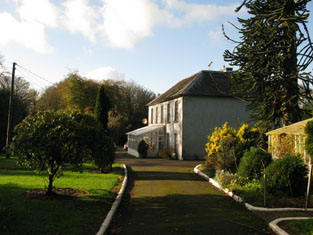
|
| Classes | Classes was occupied by William O'Callaghan in the early 1850s and held from John Stevely. The buildings were valued at £11. There are two houses at Classes on the 1st edition Ordnance Survey map. Classes House is located at W562705 while the second is labelled Classes House East and located at the site of the current Classes House which bears a date label of 1823. |
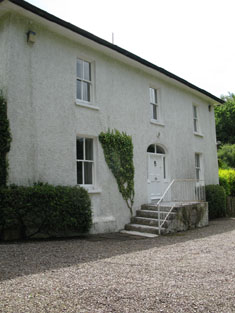
|
| Lisheens | The residence of Richard Donovan at the time of Griffith's Valuation, held from the representatives of John Stevely and valued at £16. | |
| Oriel House | Built in the first decade of the 19th century by the Board of Ordnance. The house was occupied by Charles Wilkes, the superintendant of the gunpowder mills until purchased by the Tobins of Liverpool in the mid 1830s. Mrs Tobin was a painter and their residence became known as Oriel House under Tobin ownership. The house has been a hotel since 1983. |

|
| Woodside | Wilson refers to Wood-side as the seat of Mr. Carleton in 1786. It was occupied by John Carleton in 1814 and by the Reverend E.M. Carleton in 1837. By the early 1850s the house was occupied by Horace Townsend and held by him in fee. It was valued at £40. It had become known as Kilcrenagh by the publication of the 25-inch Ordnance Survey map in the 1890s. Donnelly states that it was burnt in May 1921 during the War of Independence when it was the residence of the family of Ebenezer Pike. The National Inventory of Architectural Heritage notes that it is now in ruins. | |
| Rock Lodge | A house on the Donoughmore estate, occupied by R. Carleton in 1837 and by Henry Osborne Seward at the time of Griffith's Valuation when it was valued at £25. A house is still extant at the site. | |
| Coolyduff House | At the time of Griffith's Valuation this house valued at £16 was occupied by Alfred Parnell and held from Richard Beamish. Labelled as Coolyduff House on the 25-inch Ordnance Survey map of the 1890s. There is still an extant house at the site. | |
| Lackenshoneen | Benjamin Cross occupied this house in the mid 19th century. He held it from Philip Cross and the buildings were valued at £12. The buildings have all but disappeared on the 25-inch edition Ordnance Survey map of the 1890s and nothing remains at the site now. | |
| St Anne's Hill | Richard Barter occupied a house valued at £55 in the townland of Kilnamucky at the time of Griffith's Valuation. St Anne's Hill is marked on the first Ordnance Survey map in this townland. By the 1890s this property had become absorbed into a complex of buildings labelled Hydropathic Establishment. The National Inventory of Architectural Heritage notes that most of the complex is now in ruins though Maranatha House survives as a residence. |

|
| Ardrum | The seat of the Colthurst family, baronets, valued at £85 in the mid 19th century. The Colthursts moved from here to Blarney in the 1870s. However Sir George St John Colthurst is still given as the occupier in 1906 when the house was valued at £45. In 1944 the Irish Tourist Association survey noted it as originally the seat of the Colthursts and still owned by the family. The house is now demolished. | |
| Dawstown | A house on the Putland estate in county Cork, built by Dean Davies early in the 18th century and occupied by his family until the early 19th century. In the 1940s the Irish Tourist Association Survey claimed that he had built the house following his "being turned out of Blarney Castle by the Hollow Blade Company". George Davis was resident in 1810. Occupied by Edmond Mullane in the early 1850s and valued at £12. In the 1940s it was the residence of John Turpin. The house was accidently burnt down in 1956. | |
| Surmount/Sirmount | Sirmount was the residence of Emmanuel Moor in 1750. In 1786 Wilson refers to it as the seat of Mr. Hawkes. This house was occupied by G. Hawkes in 1837 and by Quaile Hawkes in the early 1850s. The property was held from Lady Carbery. The buildings were valued at £8.15 shillings. It is no longer extant. | |
| Bride View | Occupied by Samuel Hawkes and held from the representatives of William Hawkes at the time of Griffith's Valuation. The buildings were valued at £13.10 shillings. The property at this location is labelled Knockanemore House on the 25-inch Ordnance Survey map of the 1890s. There is still an extant house at the site. | |
| Blarney Castle | The original 15th century castle belonged to the McCarthys of Muskerry. In 1786 Wilson describes Blarney as the "very fine seat, with ample and beautiful demesnes, of Mr. Jeffreys". Lewis wrote in 1837 that Blarney Castle was purchased in 1701 by Sir James Jefferyes, Governor of Cork [from the Hollow Sword Blades Company] who “ soon after erected a large and handsome house in front of it, which was the family residence for many years, but is now a picturesque ruin”. A new house was built in 1874 on the demesne lands by the Colthurst family and is still occupied by them. |

|
| Bawnnafinny | Described at the time of Griffith's Valuation as a caretaker's house, valued at £12 and held by St John Jefferyes in fee. | |
| Woodview | A house named Wood-view near Cork was occupied by Thomas Cuthbert in 1814. The Reverend William Spedding occupied Woodview in the early 1850s. He held it from Sir George Colthurst and the buildings were valued at £12. A house is still extant at the site. | |
| Inishleena | Located on the Devonshire estate, Inishlenna Abbey was occupied by Cross Fitzgibbon at the time of Griffith's Valuation and in the 1870s. The buildings were valued at £10. The location of the Abbey is now under water as part of a reservoir. | |
| Cloghroe House | In 1786 Wilson refers to Cloghroe as the seat of Mr. Capel. In the late 18th century this house passed by marriage from the Capel family to the Fitzgerald family. J. C. Fitzgerald was resident at Cloghroe in 1814. The house, valued at £28, was occupied by Thomas Keogh in the early 1850s and held from Thomas Fitzgerald. In 1944 the Irish Tourist Association Survey referred to it as the residence of Major O'Mahony of Blarney Mills. A house is still extant at Cloghroe. | |
| Inchbeg | Located on the Fitzgerald estate, this house was occupied by Henry Young, at the time of Griffith's Valuation. The buildings were valued at £11.15 shillings and he also held a mlll valued at £84. A house is still extant at the site. |
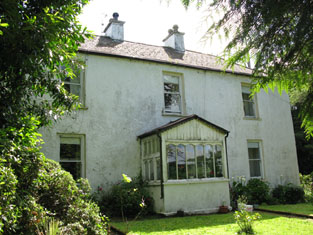
|
| Firmount | A Townsend family home, occupied by Horace Townsend in 1837 and by William Coghlan at the time of Griffith's Valuation. It was then valued at £14.10 shillings and was held from Horatio Townsend. The sale rental of 1877 records a fee farm grant of Firmount from John Crewe Chetwood Townsend to Arthur Chute dated 1871 and a fee farm grant from Arthur Chute to J.C.C. Townsend executed the following year. A house is still extant at the site. | |
| Knockane | A house valued at £14.10 shillings in the early 1850s when it was occupied by Henry Ruby and held from Samuel P. Townsend. The original house is no longer extant. | |
| Garraun | George C. Stawell held this property from Sir George Colthurst at the time of Griffith's Valuation. The buildings were valued at £7.10 shillings. This house was still occupied by the Stawells in the 1870s. A house and farm are still extant at the site. | |
| Rich Hill | A house occupied by Thomas George French at the time of Griffith's Valuation, valued at £20 and held by him in fee. | |
| Garrycloyne | Leet records Robert McCarthy occupying Garrycloyne in 1814. "Burkes Irish Family Records" states that Garrycloyne Castle was acquired by Samuel Philip Townshend from John Travers in 1837. The buildings were valued at £45 in the early 1850s and held by Samuel Townsend in fee. The house was later the home of the Barrys. In the 1940s the roof was taken off the house and it has remained a ruin ever since. | |
| Greenfort | A house valued at £10 occupied by Francis Wyse and held by him in fee at the time of Griffith's Valuation. | |
| Birchhill Cottage/Birchhill House | This house was occupied by John Travers at the time of Griffith's Valuation. He held it from Francis Wyse and it was valued at £10.10 shillings. Jane Clerke occupied a mansion house valued at £20 in this townland in 1906. It is labelled Birchhill Cottage on the 1st edition Ordnance Survey map but as Birchhill House on the 25-edition of the 1890s. A house is still extant at the site. | |
| Newcastle | The buildings at Newcastle were valued at £18 in the early 1850s, occupied by Daniel Donohoe and held from Francis Wyse. | |
| Burnfort | Burnfort valued at £7 was occupied by the representatives of Richard Harris Purcell at the time of Griffith's Valuation and held by them in fee. A house is still extant at the site. | |
| Ballyknockane | A house occupied by Thomas Ware in the early 1850s, valued at £11 and held in fee. It is labelled Ballyknockane House on the 25-inch edition of the Ordnance Survey map of the 1890s. It is now a ruin. | |
| Knockanroe | A house valued at £17 at the time of Griffith's Valuation and held by Robert A. Rogers in fee. It is not marked on the first Ordnance Survey map and was probably built in the 1840s. | |
| Cloghfadda House | Occupied by Joseph Wiseman in the early 1850s, held from Robert A. Rogers and valued at £12. The Crofts sale rental of 1881 record Cloughfadda House as a comfortable residence in "owner's hands". A house is still extant at the site. | |
| Eastly Cottage | This house was the home of Mary Anne Lombard in the mid 19th century. She held the property from the Earl of Listowel and it was valued at £20. Hajba writes that the kennels for the Duhallow Foxhounds were later located close to the cottage. Derelict for a number of years the building has been restored and was functioning as a pub in the early 21st century. | |
| Ballyellis | A home of a branch of the Norcott family in the 18th century. William Wrixon is given as the proprietor of Ballyellis, Mallow, in 1814. In 1837 Lewis refers to Bally Ellis as "formerly the residence of Lord Ennismore and now of A. G. Creagh". By the time of Griffith's Valuation Kilner Brazier held the property in fee. The buildings were valued at £60. Sold to Mr McCormick circa late 1870s and then to Nigel Baring of Baring's Bank in the 1890s. Baring was Master of the Duhallow Foxhounds for a time and changed the name of the house to Avondhu. Later bought by the De La Salle Order of Brothers. Sold by them in 1974 and demolished. | |
| Ballygarrett | Referred to in 1750 by Smith as the house of John Norcott. Leased by Sir James Cotter at the end of the 18th century to Major Stephen Kell. The Major's son, John, was occupying the house in the early 1850s, when it was valued at £18 and held from Adam Newman. Later the property of the Creaghs. This house no longer exists. | |
| Bearforest | Named after Richard Beare who held this land in the early 18th century, the house was built in 1807-1808 by Robert Delacour, a partner in the Delacour bank of Mallow. Townsend writes that it was designed by Richard Morrison. Delacour was living in the house in 1814 but had vacated it by 1837. At the time of Griffith's Valuation it was occupied by John Hugh Bainbridge who held it from James Murphy. The buildings were valued at £70. Bence Jones records the Purdon Coote family as later owners. The house was burnt in June 1921 during the War of Independence when it was the residence of Maj. Charles Purdon Coote but was rebuilt. |

|
| Carhookeal | This house was also known as Mount Watts and Castleview. It was the home of the Williamson family for most of the 19th century. Occupied by Arthur Williamson in the early 1850s and held by him from Richard Barrett. The buildings were valued at £22. Occupied by Colonel R. F. Williamson in 1906. The Irish Tourist Association Survey in 1942 noted that it used to have a third storey and that it was then unoccupied. The National Inventory of Architectural Heritage notes its use as a GAA clubhouse in this century. |
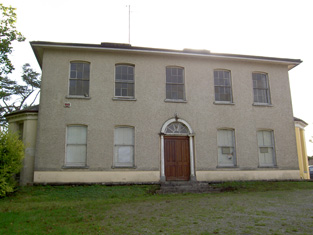
|
| Summerhill | Originally a Stawell home, Wilson refers to Summer-Hill as the seat of Mr. Stawell in 1786. It was occupied by John Stawell in the early 1850s and held from John Guinness. The buildings were valued at £18.10 shillings. Sold in 1853 to Major General Usher Williamson. The house remained in Williamson possession until the 20th century. The Irish Tourist Association Survey in 1942 recorded that it had been purchased and was resided in, by the Buckley family at that time. It is still a family residence. |
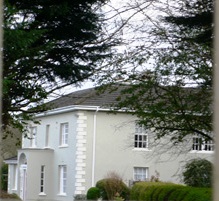
|
| Cortigan | A house on the Jephson estate, probably used as a dower house or agent's residence. At the time of Griffith's Valuation the buildings were valued at £10 and Sir C. D. Jephson Norreys is recorded as occupier. This house was not in use at the end of the 20th century. | |
| Gooldshill | At the time of Griffith's Valuation Henry Goold was leasing land in the parish of Mallow to Michael Jones. Gooldshill was occupied by Edmund Roche who held the house and 7 acres from Michael Jones. The buildings were valued at £12. Hajba writes that this house is now derelict. | |
| Rockforest Lodge | This house was the residence of Pierse Creagh in 1837. At the time of Griffith's Valuation Henry O. Seavers occupied this house, valued at £24 and held by him in fee. This house is still inhabited. In 2010 it was offered for sale. see http://www.michaelhdaniels.com/index.cfm?fuseaction=propsearch |

|
| Carrigrohane Castle | A fortified house that came into the possession of the Hoare family through marriage with a member of the Baker family in the 1770s. In 1786 Wilson refers to Carrigrohan as the seat of Mr. Colthurst. Reconstructed in the 1830s by Augustus Robert McSweeny, a corn merchant, who also leased the floor mills nearby. At the time of Griffith's Valuation Jane McSweeny was resident. The Castle later reverted back to the Hoares who owned it until the 1940s. They are mentioned by the Irish Tourist Association survey as resident there. It is still extant. |

|
| Rockvale | Lewis refers to this recently erected mansion of Samuel George Beamish. In the early 1850s it appears to be unoccupied and valued at £12, the land was held by Michael Kelleher from S. G. Beamish. This house no longer exists. | |
| Bishop's Island | Grice Richard Smyth held buildings valued at £25 in the townland of Bishop's Island at the time of Griffith's Valuation. ''Burke's Irish Family Records'' refers to his father Henry Mitchell Smyth of Bishop's Island. In 1786 Wilson notes Bishop's Island as the seat of Mr. Mitchell. | |
| Bridestown | Leet records the Reverend Edward Carleton as resident at Bride-town, Rathcormack. E. Morgan was the proprietor in 1837 and at the time of Griffith's Valuation, holding the property in fee. The buildings were valued at £42. Bence Jones writes that the Morgans sold the property in the second half of the 19th century having been ruined by the gambling of Lady Louisa Morgan, known as "Unlimited Loo". Later the home of the Lindsay and Horgan families and still occupied. |

|
| Killuntin | Home of a branch of the Roche family, occupied by Edmund Roche in 1814, by R. Roche in 1837 and by Richard V. Roche at the time of Griffith's Valuation. Richard Roche held the property in fee and the buildings were valued at £15.10 shillings. Hajba records the house as a ruin. | |
| Glenville | Originally a Coppinger property sold to the Hudsons in the mid to late 18th century. The Hudsons built a new house and this house was added too in 1887. E. G. Hudson was resident at Glenville in 1814 and Lewis records the Reverend E. G. Hudson as the proprietor of Mount Pleasant in the parish of Ardnageehy in 1837. In the mid 19th century William E. Hudson held the property valued at £46 in fee. Inherited by William E. Hudson's nephew Sir Edward Hudson Kinahan who was the occupier in 1906 when the house was valued at £150. Sold to the Bence Jones family in 1949. Also known as Mount Prospect and The Manor, this house was the home of Mark Bence Jones, author. |
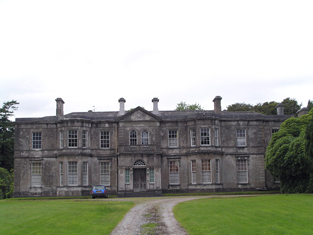
|
| Butlerstown | Nathaniel C. Martin held a house, offices, foreman's house and spade factory valued at £25 from Francis Beamish. The property is labelled Butlerstown House on the 25-inch Ordnance Survey map of the 1890s when the spade factory is no longer visible. There is still an extant house at the site. | |
| Carrignavar | The castle of Carrignavar was from the mid 17th century the seat of this the senior branch of the McCarthy clan. Bence Jones writes that Carrignavar is a late 19th century castellated house incorporating the remains of the old castle. Lewis refers to Carrignavar as the seat of Justic McCarthy in 1837 and Justin McCarthy junior was resident at the time of Griffith's Valuation when the buildings were valued at £28. Bought by John Sheedy in the 20th century and sold by him in the 1950s to the Sacred Heart Fathers. The house is part of their college complex. |

|
| Mitchellsfort/Fellfort | This house was the home of Mitchell Esq in the 1770s and 1780s. Occupied by Brooke Brazier in 1814 and by his son Henry B. Mitchell in the early 1850s. Henry B. Mitchell owned the property in fee and the buildings were valued at £52+. Slater noted it as the residence of R.L. Fell in 1894, now demolished. | |
| Hermitage | A house valued at £18, occupied by Eliza Martin and held from Robert Webb at the time of Griffith's Valuation. In the 20th century the home of Edmund Glen Browne. |

|
| Wood View | The home of J. Cremen in 1837 and Jeremiah Crimmin in the early 1850s, when the house was valued at £16 and held from Thomas Wyse. | |
| Sarsfieldscourt [Old] | In 1837 Lewis refers to Sarsfieldscourt as an ancient mansion "formerly belonging to the Sarsfield family but now to Mr Rutland [Putland] of Dublin". On the first Ordnance Survey map one building is marked as "in ruins". Another building also named Sarsfield's Court is marked closer to the Glashaboy River. At the time of Griffith's Valuation Charles Putland junior was recorded as occupier, holding the house valued at £13 from his father Charles Putland. This latter property is labelled Beechmount on the 25-inch Ordnance Survey map of the 1890s. A property labelled Sarsfieldcourt House is also located in the townland on the later map [W723779]. It is no longer extant and St.Stephen's Hospital now occupies the grounds. | |
| Doughcloyne | Originally the home of the Ronayne family, it passed by marriage to the Sarsfields. Occupied by Dr Sarsfield in the 1770s and 1780s, by Mr Haynes in 1814, by D. Sarsfield in 1837 and by Thomas R. Sarsfield in the early 1850s, who held it in fee, value £43. In 1894 Slater notes it as the seat of Capt. T.R. Sarsfield. This house is no longer extant. | |
| Turret Farm House | At the time of Griffith's Valuation occupied by St John Jeffreys and held by him in fee, the buildings were valued at £26. | |
| Leemount | The residence of John T. Hartnell in 1814 and of Nicholas C. Brabazon at the time of Griffith's Valuation. Brabazon held the house valued at £72 from St John Jeffreys with 118 acres. The 1870s landowners' records indicate it as owned by Henry Lindsey Young and Slater records it as his residence in 1894. Leemount is still extant. |

|
| Mount Desert | The home of the Dunscombe family in the 18th and 19th centuries, it was noted by Wilson as the seat of Mr. Dunscombe in 1786. The house was occupied by George Dunscombe in 1814 and by Nicholas Dunscombe in the early 1850s when it was valued at £55. Still valued at the same amount in 1906 when it was occupied by Robert Dunscombe. The house is no longer extant and the Bon Secours Health Care unit is now located at this site. |

|
| Park Farm House | Henry Morrogh of Park Farm was a younger son of James Morrogh of Cork. He was resident at Park Farm in 1837 and in the early 1850s when the house was valued at £35 and held in fee. He married Helena Power. Mrs Helen Morrogh owned 828 acres in county Cork in the 1870s. | |
| Lauriston | A house valued at £40 at the time of Griffith's Valuation and held by Nicholas D. Murphy from Joseph Anderson. | |
| Kilbarry | In the mid 19th century occupied by George Wise and held from James H. S. Barry. The buildings were valued at £35. | |
| Ballygaggin | Occupied by Edmond Murphy at the time of Griffith's Valuation, valued at £30 and held from the Duke of Devonshire. | |
| Lee Cottage | Marked on the first Ordnance Survey map this house was occupied by Henry O. Seward in the early 1850s when it was valued at £52 and held from the Ecclesiastical Commissioners. Now incorporated into the university. | |
| Ashton | A house occupied by John Cotter from at least 1814 until his death in 1864 and by Mrs Catherine Cotter until at least 1871. It is not clear if John Cotter was a member of the Cotter family, baronets. The house is now part of the Ashton School complex. | |
| Ballyphilip House | This property was leased to Samuel Adams Austen and occupied by John Forrest in the early 1850s. When the Newenham's fee of Ballyphilip was for sale in 1865 David Cagney was resident. A house still exists at the site. | |
| Gawsworth | In the mid 19th century this house valued at £19 was occupied by Russell Fitton and held from the representatives of Robert Hedges and Mr Pratt. | |
| Woodhill | Originally this property belonged to the Dennis family. Following the marriage of Elizabeth Dennis to Cooper Penrose, a Quaker, of Waterford, it passed into the possession of the Penrose family, who enlarged the house. Another Cooper Penrose was the occupant in 1814 and in the mid 19th century holding the property from James Murphy. The buildings were valued at £100. The house was demolished circa 1980s. | |
| Ballycannon | The home of the Spread family in the 18th century, by the time of Griffith's Valuation the buildings were valued at £7 and occupied by Michael and John Daly who held the property from the representatives of William Spread. A building is still extant at this location. | |
| Trantstown | A Trant home in the 18th century, occupied by Mrs Pepper in 1837 and by James Barry in the early 1850s. He held the house valued at £8+ from Lady A.H. Fitzgerald. Buildings are still located at this site. | |
| Deeshart | Denis Fielding held a house, office and mills valued at £28 from John H. Colthurst at the time of Griffith's Valuation. This may be the premises labelled "Carding Mill" on the 1st edition Ordnance Survey map and as "Dripsey Woollen Mills" on the 25-inch edition of the 1890s. Industrial buildings still exist at the site. | |
| Wilton | In 1786 Wilson refers to "Willtown" as the seat of Mr. Izod. Charles H. Leslie occupied Wilton in 1814 and in 1837. By the mid 19th century Matthew Leslie was resident, holding the house valued at £55 from John Craig and H. Mitchell. A college is now located at this site. | |
| Shanakiel | Daniel Leahy is recorded as the occupier of Shanakiel House in the first half of the 19th century. The house was valued at £85 in the early 1850s and held from the Earl of Cork and Orrery. This house no longer exists and its site is located in the grounds of a hospital. | |
| Maglin | A house valued at £15 and held by James Barry [Berry] from John Popham and others at the time of Griffith's Valuation. Buildings are still extant at this location. | |
| Rosanna | Rosanna was the home of the Webb family in the 19th century, occupied at the time of Griffith's Valuation by Hannah (widow of the Reverend Dr John Webb) valued at £75 and held from St John Jeffreys. A building is still located at this site. | |
| Spud Villa | This house is marked on the first edition Ordnance survey map. Anne and Jane Wise occupied a house in the townland of Mount Desert valued at £38 and held from Thomas Wise in the mid 19th century. | |
| Rathpeacon House | At the time of Griffith's Valuation, Rathpeacon House was occupied by William le Fanu leasing from Richard Thomas when the house was valued at £27. In the 1870s it is recorded as the residence of John Davis. | |
| Dripsey Lodge | At the time of Griffith's Valuation this property was occupied by Alfred Greer, leasing from Sir William Magny. The house was valued at £26 while the adjacent paper mills had a valuation of £120. It is named as Dripsey House on the 25-inch Ordnance Survey map of the 1890s. The house is no longer extant. | |
| Ballincollig | In 1786, Wilson mentions a seat of Mr.Lloyd at Ballincollig, "near the ruins of the castle". By the time of Griffith's Valuation, this area appears to have been in the possession of Thomas Tobin and the house may have been that leased by Rev. David Horgan, when the buildings were valued at £14. A substantial farm still exists at this site. | |
| Greenfield (Ballincollig) | In 1786, Wilson refers to Greenfield, near Ballincollig, as the seat of Mr. Carleton with another house, the seat of Mr. Wetheral, opposite. Greenfield House is labelled on the 1st edition Ordnance Survey map but is not shown on the 25-inch edition of the 1890s. Greenfield Upper, across the road, is shown on both maps. At the time of Griffith's Valuation this townland was in the possession of Francis Carleton. Greenfield House was valued at £11 while the second house in the townland was valued at almost £10. Neither were occupied. A building is still extant at the Greenfield Upper site though extensive modern housing has been built in the surrounding area. |

